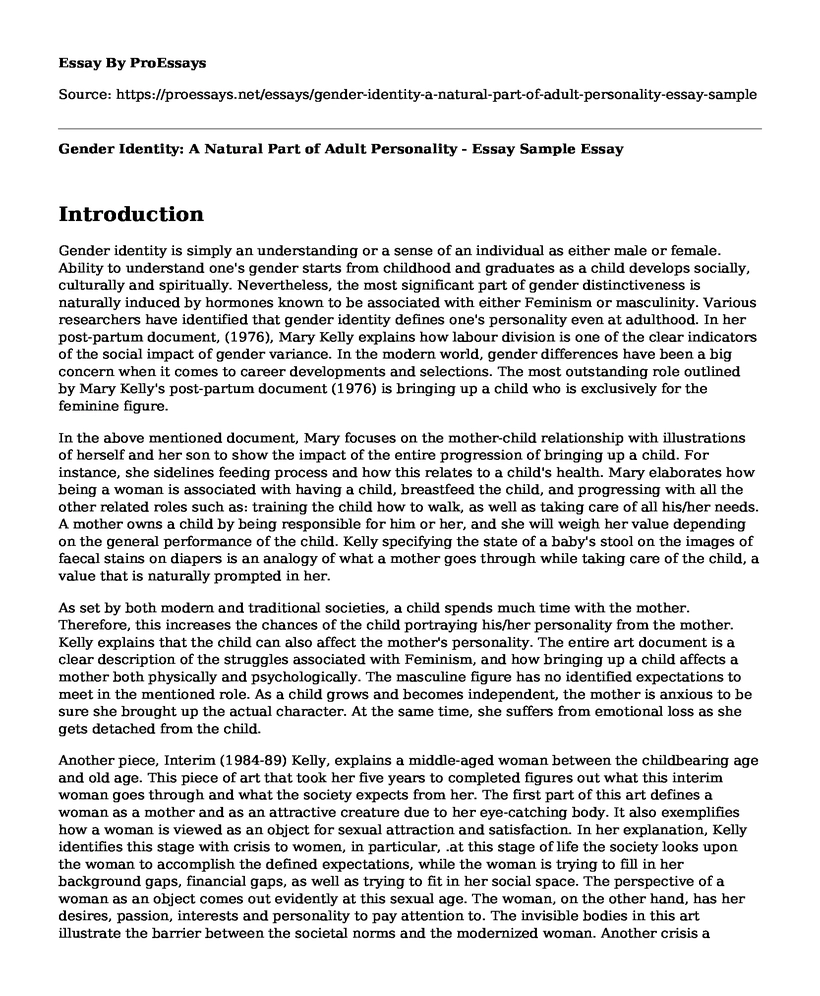Introduction
Gender identity is simply an understanding or a sense of an individual as either male or female. Ability to understand one's gender starts from childhood and graduates as a child develops socially, culturally and spiritually. Nevertheless, the most significant part of gender distinctiveness is naturally induced by hormones known to be associated with either Feminism or masculinity. Various researchers have identified that gender identity defines one's personality even at adulthood. In her post-partum document, (1976), Mary Kelly explains how labour division is one of the clear indicators of the social impact of gender variance. In the modern world, gender differences have been a big concern when it comes to career developments and selections. The most outstanding role outlined by Mary Kelly's post-partum document (1976) is bringing up a child who is exclusively for the feminine figure.
In the above mentioned document, Mary focuses on the mother-child relationship with illustrations of herself and her son to show the impact of the entire progression of bringing up a child. For instance, she sidelines feeding process and how this relates to a child's health. Mary elaborates how being a woman is associated with having a child, breastfeed the child, and progressing with all the other related roles such as: training the child how to walk, as well as taking care of all his/her needs. A mother owns a child by being responsible for him or her, and she will weigh her value depending on the general performance of the child. Kelly specifying the state of a baby's stool on the images of faecal stains on diapers is an analogy of what a mother goes through while taking care of the child, a value that is naturally prompted in her.
As set by both modern and traditional societies, a child spends much time with the mother. Therefore, this increases the chances of the child portraying his/her personality from the mother. Kelly explains that the child can also affect the mother's personality. The entire art document is a clear description of the struggles associated with Feminism, and how bringing up a child affects a mother both physically and psychologically. The masculine figure has no identified expectations to meet in the mentioned role. As a child grows and becomes independent, the mother is anxious to be sure she brought up the actual character. At the same time, she suffers from emotional loss as she gets detached from the child.
Another piece, Interim (1984-89) Kelly, explains a middle-aged woman between the childbearing age and old age. This piece of art that took her five years to completed figures out what this interim woman goes through and what the society expects from her. The first part of this art defines a woman as a mother and as an attractive creature due to her eye-catching body. It also exemplifies how a woman is viewed as an object for sexual attraction and satisfaction. In her explanation, Kelly identifies this stage with crisis to women, in particular, .at this stage of life the society looks upon the woman to accomplish the defined expectations, while the woman is trying to fill in her background gaps, financial gaps, as well as trying to fit in her social space. The perspective of a woman as an object comes out evidently at this sexual age. The woman, on the other hand, has her desires, passion, interests and personality to pay attention to. The invisible bodies in this art illustrate the barrier between the societal norms and the modernized woman. Another crisis a woman fights with is the worry of getting old. In this regard, she has the pressure to catch up with the time frame, identify herself and achieve her dreams before she gets old. This creates a sense of contest between the female involved and the entire humanity that do not recognize the forces behind the woman. Another illustration of art is language. The social misunderstandings hinder the need for a woman to be understood by the surrounding society.
Although Mary Kelly in both pieces (post-partum document and interim, (n.d) focus on the problems associated with Feminism from childhood to old age, she does not provide solutions to the same issues. Gender revolution has brought the conflict to gender identity and therefore calling for action to influence the young generation with the factual understanding of gender difference. As outlined above, Feminism and masculinity is hormonal to a more significant extend and cannot be changed. Even so, some levels of divisions, especially in career, are cultural. Both male and female genders should have insights about who they are and who they are capable of becoming whether in terms of social interactions, career choices, and societal roles. Although some functions like childbearing and upbringing may not change from being handled by women, being a male or a female should never be a barricade to achieving what an individual would want to succeed in this modern world.
References
Interim. (n.d.). Retrieved from http://www.marykellyartist.com/interim.html
Post-Partum Document. (n.d.). Retrieved from http://www.marykellyartist.com/post_partum_document.html
Cite this page
Gender Identity: A Natural Part of Adult Personality - Essay Sample. (2023, Mar 04). Retrieved from https://proessays.net/essays/gender-identity-a-natural-part-of-adult-personality-essay-sample
If you are the original author of this essay and no longer wish to have it published on the ProEssays website, please click below to request its removal:
- The Bridge Between Childhood and Adulthood - Essay Sample
- Why People Behave the Way They Do? Essay Example
- Essay Sample on Coaching International Workers Who Experience Burnout and Stress Problems
- Essay Sample on Cope With Stress: Causes, Effects, and Solutions
- Paper Example on Suicide: A Global Tragedy With Individual Implications
- Essay Example on Mental and Emotional Health: Impact on Bodily Health
- Free Personal Statement Sample on Pursuing an MBA







